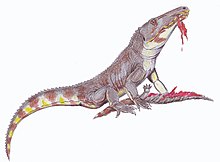Архозавриформы
Материал из Википедии — свободной энциклопедии
| Архозавриформы | ||||||||
|---|---|---|---|---|---|---|---|---|
 1-й ряд (базальная группа): Erythrosuchus africanus, Euparkeria capensis (эвпаркерия); | ||||||||
| Научная классификация | ||||||||
|
Домен: Царство: Подцарство: Без ранга: Без ранга: Тип: Подтип: Инфратип: Надкласс: Клада: Клада: Класс: Подкласс: Клада: Клада: Инфракласс: Клада: Архозавриформы |
||||||||
| Международное научное название | ||||||||
| Archosauriformes Gauthier, 1986 | ||||||||
| Подгруппы | ||||||||
|
||||||||
| ||||||||
Архозаврифо́рмы[2] (лат. Archosauriformes) — клада пресмыкающихся из подкласса диапсид, произошедшая от архозавроморфных предков в верхнем пермском периоде (около 250 млн лет назад). Была определена Жаком Готье в 1994 как клада животных, имеющих последнего общего предка с группами Proterosuchidae и Archosauria[3]. Ранние представители, протерозухии, были крокодилоподобными наземными животными около полутора метров в длину, с широко расставленными конечностями и длинными мордами. В отличие от большинства терапсид, они выжили в Великом пермском вымирании, после чего быстро эволюционировали и дали начало другим группам: эритрозухиям и Eucrocopoda, от которых впоследствии произошли архозавры, со временем занявшие освободившиеся после вымирания экологические ниши.
Эволюция
[править | править код]Кладограмма по работе Sengupta и коллег (2017)[4], основанной на исследовании Ezcurra 2016 года[5]:
| Archosauriformes |
| |||||||||||||||||||||||||||||||||||||||||||||||||||||||||||||||||||||
Существуют альтернативные кладограммы (Nesbitt, 2011)[6]:
| Archosauriformes |
| ||||||||||||||||||||||||||||||||||||||||||||||||||||||||||||||||||
Отдельные представители
[править | править код]

- † Chasmatosuchus Huene, 1940 — род из нижнего триаса Приуралья (Верхняя Ветлуга, оленёкский ярус). Известен по фрагментарным остаткам, длина черепа до 25—30 см. По-видимому, питался мелкой добычей, зубы сильно изогнуты назад, длинные, тонкие. Типовой вид — C. rossicus.
- † Collilongus rarus Borsuk−Białynicka & Sennikov, 2009 — жил в среднем триасе около 245 млн лет назад на территории современной Польши.
- † Cuyosuchus huenei Reig, 1961 — описан из верхнего триаса (норий) Аргентины.
- † Fugusuchus hejiapanensis Cheng, 1980 — вид из нижнего — среднего триаса Китая.
- † Kalisuchus rewanensis Thulborn, 1979 — крупный диапсид до 3 метров длиной. Найден в нижнетриасовой формации Аркадия в Квинсленде. Отличается лёгким телосложением и относительно длинной шеей.
- † Tasmaniosaurus triassicus Camp & Banks, 1978 — описан из нижнетриасовых слоёв формации Ноклофти в Тасмании. Это мелкое животное, около 1 метра длиной, похожее на Proterosuchus.
Литература
[править | править код]- Кэрролл Р. Палеонтология и эволюция позвоночных. Т. 2 — М.: Мир, 1993. — С. 65—67.
- Ископаемые рептилии и птицы. Ч. 1. / под ред. М. Ф. Ивахненко и Е. Н. Курочкина. — М.: ГЕОС, 2008. — С. 284—291.
- Gauthier, J. A.[англ.]. Saurischian monophyly and the origin of birds // The Origin of Birds and the Evolution of Flight. Memoirs of the California Academy of Sciences (англ.) / Padian, K. (ed.). — California Academy of Sciences, 1986. — Vol. 8. — P. 1—55. — ISBN 0-940228-14-9.
- Gauthier J. A.; Kluge A. G.; Rowe T. Amniote phylogeny and the importance of fossils (англ.) // Cladistics. — John Wiley & Sons, 1988. — June (vol. 4, no. 2). — P. 105—209. — doi:10.1111/j.1096-0031.1988.tb00514.x.
Примечания
[править | править код]- ↑ Sookias, R. B.; Sullivan, C.; Liu, J.; Butler, R. J. (2014). "Systematics of putative euparkeriids (Diapsida: Archosauriformes) from the Triassic of China". PeerJ. 2: e658. doi:10.7717/peerj.658. PMC 4250070. PMID 25469319.
((cite journal)): Википедия:Обслуживание CS1 (не помеченный открытым DOI) (ссылка) - ↑ Уиттон М. П.[англ.]. Птерозавры = Pterosaurs: Natural History, Evolution, Anatomy : ориг. изд. 2013 : [пер. с англ.] / науч. ред. А. Аверьянов. — М. : Фитон XXI, 2020. — С. 25. — 304 с. : ил. — ISBN 978-5-906811-88-2.
- ↑ Gauthier J. A. (1994). The diversification of the amniotes. In: D. R. Prothero and R. M. Schoch (ed.) Major Features of Vertebrate Evolution. Knoxville, Tennessee: The Paleontological Society. P. 129—159.
- ↑ Sengupta S., Ezcurra M. D., Bandyopadhyay S. A new horned and long-necked herbivorous stem-archosaur from the Middle Triassic of India (англ.) // Scientific Reports : journal. — 2017. — Vol. 7. Архивировано 2 сентября 2021 года.
- ↑ Ezcurra M. D. (2016). The phylogenetic relationships of basal archosauromorphs, with an emphasis on the systematics of proterosuchian archosauriforms. PeerJ: e1778. doi:10.7717/peerj.1778.
- ↑ Nesbitt S. J. The early evolution of archosaurs: relationships and the origin of major clades (англ.) // Bulletin of the American Museum of Natural History[англ.] : journal. — American Museum of Natural History, 2011. — Vol. 352. — P. 1—292. — doi:10.1206/352.1. Архивировано 1 июля 2019 года.
Ссылки
[править | править код]- Описание архозавроморфов (англ.)
- Mikko’s Phylogeny Archive (англ.)
Text is available under the CC BY-SA 4.0 license; additional terms may apply.
Images, videos and audio are available under their respective licenses.
